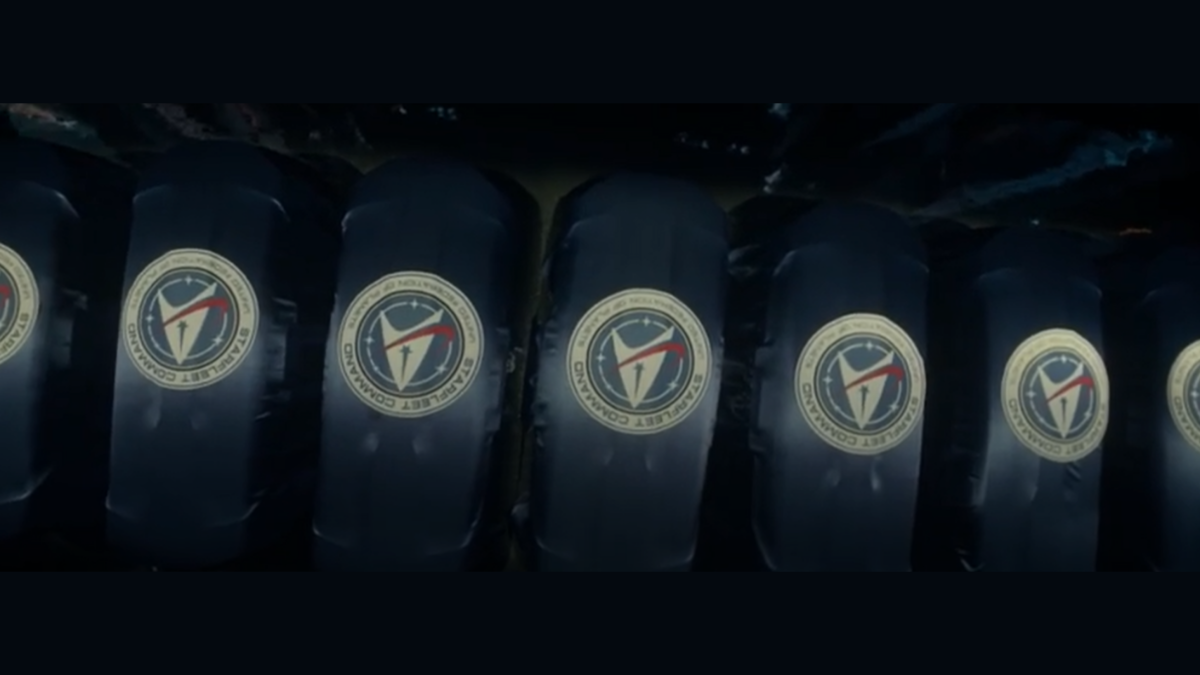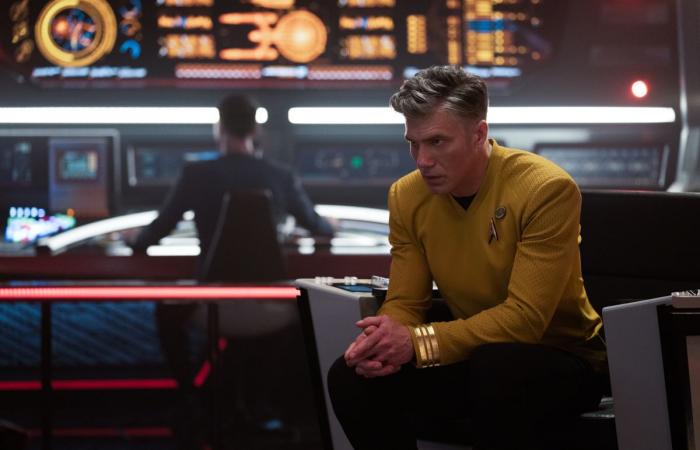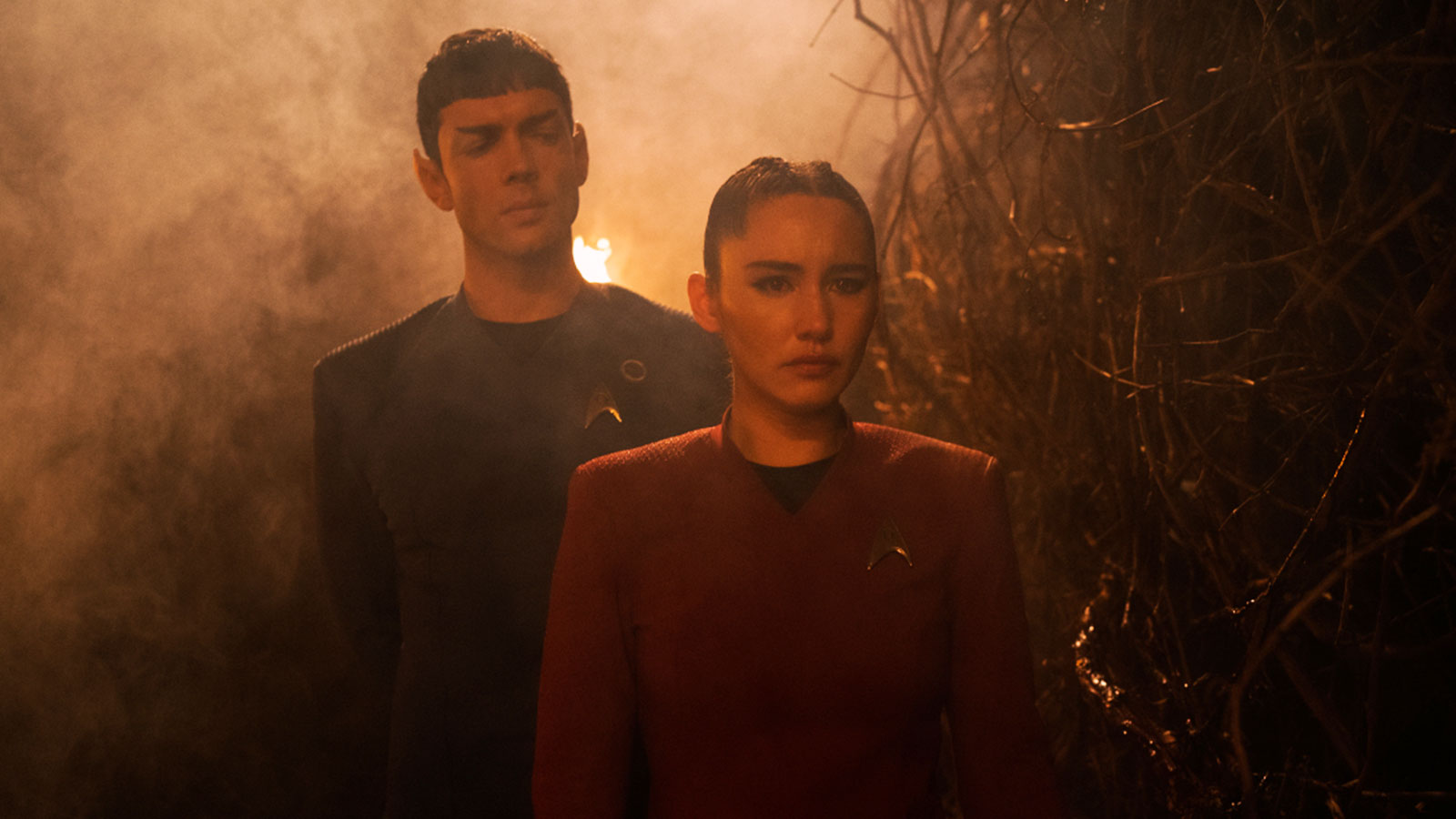
‘Memento Mori’: To live with the prospect of death (Strange New Worlds)
Reading Time: 9 minutes Like any self-respecting Trekkie, I learned the basics of gunpower from Star Trek: The Original Series. One of TOS‘s most memorable scenes comes from “Arena” (Season 1, Episode 18), when Captain Kirk, trapped on a planet with minimal resources, has to use his wits to survive
Like any self-respecting Trekkie, I learned the basics of gunpower from Star Trek: The Original Series. One of TOS‘s most memorable scenes comes from “Arena” (Season 1, Episode 18), when Captain Kirk, trapped on a planet with minimal resources, has to use his wits to survive an encounter with a brutish reptilian species called the Gorn. Fortunately for Kirk, the terrain holds sulfur, charcoal, and saltpeter. Folks may remember the Gorn’s goofy 1960s costuming, or Kirk’s loose approximation of a gunpowder formula (10:15:75) that it took Roger Bacon years to perfect for the West.
But do you remember that Kirk, triumphant, refused to kill his attacker?
Star Trek has a long history of taking death seriously, especially around questions of sacrifice and complicity: Spock’s sacrifice in The Wrath of Khan. Picard’s role as Locutus of Borg in the massacre at Wolf-359. The Doctor’s choice to save a friend’s life in “Latent Image” (Voyager, S5E11). However, the franchise is also so well known for casually killing off crew that the “redshirt” is a whole cultural meme (and goofy John Scalzi book). Moreover, in J.J. Abrams’ hands? Oh, you know it: the franchise dramatically wiped out a whole planet. And Discovery Season 4 followed suit, by destroying another fully populated homeworld to motivate a single character’s journey through grief over the season.
Strange New Worlds was wise, then, to establish early on how it would approach death and sacrifice. “Memento Mori” gives us that answer in a humanist trove of mortal peril.
Establishing the stakes (Spoiler-free zone)
Mind you, “Memento Mori” also establishes quite a bit more than SNW‘s approach to death and sacrifice. During a crisis that relentlessly worsens, the show puts the whole Enterprise through its paces, so that viewers can see the ship’s limits and possible breaking points, along with the crew’s usual behavior and standard operating procedures in emergency situations. This is excellent foundational detail for future stories, too.
In this story, though, La’an’s officer’s log first informs us of the Enterprise’s current mission: to deliver an atmospheric upgrade to a distant colony, Philebus 3, with only weeks of breathable air left. It’s also Remembrance Day, when the crew wears pins in honor of past ships where they served, and any colleagues whose explorations ended in death. La’an, who’s had a traumatic past among the Gorn, decides not to wear hers. (This will concern Number One, but La’an will assert that she doesn’t need someone poking around in her head.) Meanwhile, Cadet Uhura is on rotation with Chief Engineer Hemmer, who emphasizes that he expects more than theoretical know-how from her during their workshift.
All of these are potent staging pieces for any number of storylines, and the main mission could very well have presented striking moral quandaries. But when the Enterprise arrives, there’s no response from the surface. Spock speculates and rules out interference from a nearby brown dwarf star. An orbital satellite’s been destroyed. By accident, or design?

Everything in this set-up is handled with attention to empiricism. The crew approaches the rapidly changing scenario without leaping to conclusions, and by methodically testing and ruling out hypotheses. An away team finds blood trails and destruction, signs of a skirmish, but no life. A ship appears, but it’s not putting out normal signals. When it does, it seems to be harboring wounded survivors. But of what?
The Enterprise bridge crew proceeds with caution, withholding judgment. The littler ship’s construction blocks transporters, so a manual corridor is engaged. The Enterprise’s shields lower. That’s when La’an, in talking with a survivor, realizes this is a Gorn trap.
Too late. The Gorn, a species that has used humans as feed sacks for its young, attack. The Enterprise is hit hard, losing critical systems and most defensive and offensive capabilities. Survival can only come by leaping from the frying pan into the fire: the brown dwarf’s outer gasses. Oh, and did I mention that this star was being pulled into a black hole?
Hemmer and Uhura are trapped in shuttle bay with a perilously overheating coolant system.
Dr. M’Benga and Nurse Chapel are handling sickbay overflow with very little future-tech.
And the bridge crew, with only one photon torpedo that they can’t even fire normally near the brown dwarf, have to draw upon their wits, and La’an’s experiences of the Gorn.
Nothing gets easier. The ship will see casualties before the end of day.
Read: Strange New Worlds: Star Trek’s return to humanist form
Challenging expectations (Spoiler zone)
As the situation worsens, various crew members need to take greater risks. Uhura thinks like a cadet at the outset, when taking the place of Hemmer’s wounded hands, but even when she rises to every challenge set by the coolant unit, it’s not enough. Sometimes our best efforts never are. The two have to brace for a full venting of the shuttle bay.
At the same time, Chapel rises steadily to the challenges of more rudimentary medicine, all while informing her patient of the differences in treatment plan, to prepare Number One for the heightened risk of death compared to typical twenty-third-century outcomes.
And two average crewmates, on a lower deck that will eventually need to be cut off to protect the rest of the ship’s hull integrity, have to make a snap decision.
But the episode’s greatest struggles lie with Captain Pike and La’an. Pike has excellent plans, but the enemy is crafty, too, so his expert use of the lone torpedo only makes the problem worse: revealing their location to other vessels while killing what he thought was but one attacker. Meanwhile, La’an has to grapple with her suppressed memories (in a sly fruition of her earlier comment about therapy, by literally letting someone into her mind after all), and is rewarded with a memory that holds one key to tricking the enemy.

As one enemy ship becomes multiple, Pike continues to make major life-or-death decisions. Hiding in the brown dwarf’s periphery will eventually crush the Enterprise. Leaving its protection would put the Enterprise in plain view of the enemy. Armed with cautionary intel from Ortegas and Spock, Pike puts his trust in his vessel and finds an opportunity (tied neatly into the overheating coolant unit) to use gravitational lensing to trick the enemy into thinking the Enterprise has been destroyed while it slingshots to freedom.
But in the line of duty, seven crewmates still die. And so an episode that started with remembrance ends on it, too, rounding out the idea that we, in honoring the dead, are also honoring the prospect of death in us. In life. In the course of any daily mission that could easily start out normally, and ever so suddenly become a nightmare instead.
Humanist narrative structure?
I was a bit worried when I saw La’an foregrounded, because in less humanist shows it’s common to focus on the one character with a personal connection to the main crisis (in this case, to the Gorn, who terrorized La’an and killed her loved ones), and to prioritize that character’s experience over all others. That kind of storytelling completely distorts the universe, and gives the impression that the crisis is essentially unfolding so that one human being can learn an important lesson, or grow in some other way.
This approach would not have been wise for an episode trying to highlight how many people are differently affected by shared mortal peril. Fortunately, SNW‘s writers instead chose to spread out the insights from this life-or-death struggle. (The production team also made the excellent narrative choice not to show the Gorn at all, save for their vessels. This reinforces Pike’s reminder that fear is the only enemy the crew has to overcome.)
Now, it’s certainly true that La’an’s unresolved trauma plays a role in the plot. It first makes her a less capable officer, then a more capable one. And it gives her and Spock an opportunity to bond. But perhaps most potently for future episodes, this backstory also gives her the moral authority to argue that the Gorn present an insurmountable challenge to the Federation’s baseline assumption that every current enemy can be befriended. Some cannot, she argues, because they simply do not care about our lives.
It’s a critical perspective for this series, but not the only one carrying the hour. Alongside La’an’s character arc, we also have Hemmer learning to accept help, and guiding Uhura through her fear of death by offering his species’ philosophy, that death only comes when we have finished our life’s purpose. We also have a lower-deck officer making the ultimate sacrifice without first working through theory at all. And we have Pike, pained to hear of the death of a crewmate after a necessary decision on his part, consoled thusly:
Spock: You made the logical choice.
Pike: Why doesn’t it feel like that?
Spock: For the same reason that you made it. Because you value life.
‘Memento Mori’: the thematic payoff
The core journey in this episode, in other words, is not “about” any one crewmate.
By the end, La’an isn’t magically healed of her cynicism, and Pike is no more magically healed of his optimism. (Or his inordinate faith in the Enterprise holding up against whatever the universe might throw at them.) Spock retains his even-handed Vulcan point of view. And for Chapel and M’Benga? This was a hectic but also not-so-unfamiliar day.
Meanwhile, some characters grew in ways that will plainly inform future behavior. Hemmer warmed to a crewmate and the idea of teamwork. Uhura took important steps out of her mostly academic approach to Starfleet, into the deeper testing grounds of active duty.
Even Chief Kyle received the most extraordinary and devastating gift.
And Ortegas? Oh, no biggie: She’s just the actual person who hauled the Enterprise into safe territory, and only got a little lippy with her captain about the odds along the way.
Collectively, then, “Memento Mori” presents the fact of living with the prospect of death as something that we all do in our own way. The episode seeks no uniformity in how we bear up to our mortality, and certainly offers no guarantee that surviving mortal peril will somehow make us superior, stronger, or wiser in predictable ways.
That we are still alive today, to reflect on the death that may well meet us today, has to be binding thread enough. Everything else, SNW leaves for viewers to decide for themselves. A full four happy humans to this episode, for creating a wide enough playing field for personal reflection on what memento mori (“Remember, you must die”) might mean to each of us.
Quotes of note, and Easter eggs
- Nurse Chapel continues to break from TOS‘s moony-eyed, beehive-blonde puppy-dog for Spock with fun reveals, including her hobby interest in “archaeological medicine” and some choice words for a reluctant patient: “We could take bets on when septic shock begins? I hear it’s like giving birth out your mouth.” Not yo’ mama’s Nurse Chapel!
- Not sure if this was intentional, but if I heard the name of the colony correctly, Philebus 3 might be a neat thematic reference slipped into the world itself. Philebus was a character in Socratic dialogues who advocated (somewhat indirectly, at a distance from the main debate) for the value of pleasure above all else. Socrates argues instead for the superiority of wisdom, memory, and true reasoning: all present in this episode.
- There’s a powerful Wrath of Khan and “Balance of Terror” (TOS S1E14) vibe to the way the Enterprise and the Gorn dance around each other in the obscurity of the clouds. The first reference plays nicely off La’an’s other backstory, as a descendant of Khan.
- Captain Pike’s shipwide address offers a resonant lesson for us all: “Attention, this is the captain speaking. Earlier today we were reminded of the cost of exploration. What it means to chart the stars. To push the boundaries of what is known and what is possible. When we seek out the unknown, we will find things that challenge us. Frighten us. But we do not back down. We do not give in to fear.“
- TOS has Captain Kirk use a slingshot maneuver twice to get the Enterprise out of danger, once in “Tomorrow is Yesterday” (S1E19) and again in the now-slightly-retconned (care of Picard, Season 2) “Assignment: Earth” (S2E26). But SNW has now adorably staked its claim on this being The Pike Maneuver. Will fans riot?
- Chief Engineer Hemmer gets Quote of the Week for his explanation of what an Aenar (a pacifist subspecies of Andorian) is doing in Starfleet: “I will not fight for Starfleet, but I will defend its ideals. Pacifism is not passivity. It is the active protection of all living things in the natural universe.” Delivered with such deft, off-the-cuff gravitas, too!
Star Trek: Strange New Worlds
Season 1, Episode 4: “Memento Mori”

